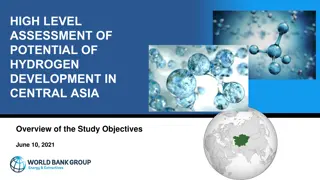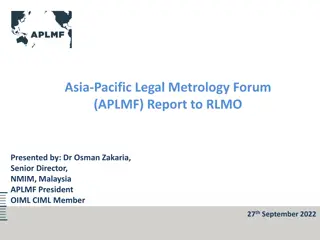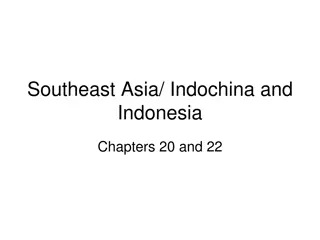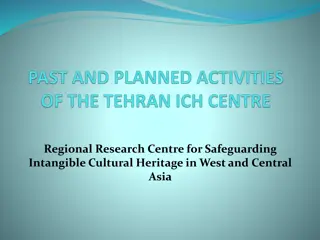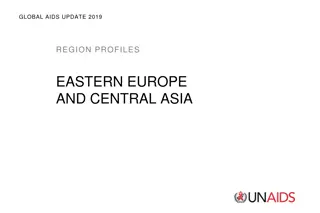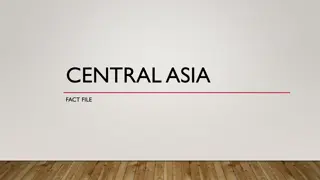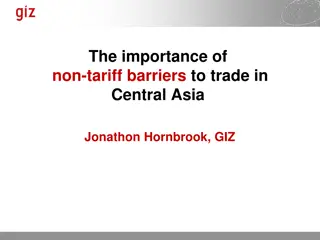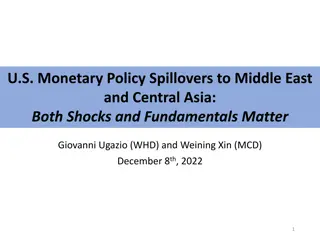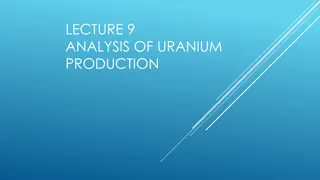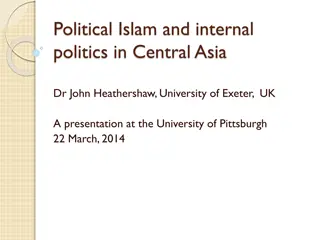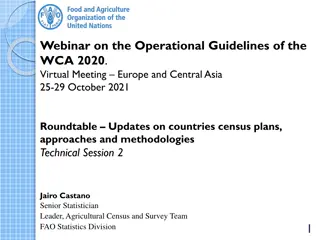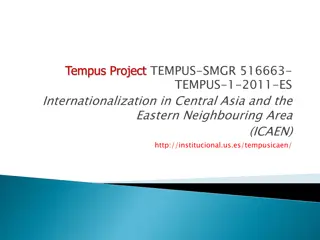Understanding Central Asia: Dynamics and Influences
Central Asia and its neighboring regions exhibit a complex interplay of various powers and influences, shaping geopolitical landscapes. With no single dominant force, the region witnesses the rise of China, endeavors by Russia to maintain influence, and US/European strategies influenced by the Afghan War. The definition and significance of Central Asia, characterized by contrasting terrains, languages, and historical empires, are subjects of ongoing debate.
Download Presentation

Please find below an Image/Link to download the presentation.
The content on the website is provided AS IS for your information and personal use only. It may not be sold, licensed, or shared on other websites without obtaining consent from the author. Download presentation by click this link. If you encounter any issues during the download, it is possible that the publisher has removed the file from their server.
E N D
Presentation Transcript
Central Asia and Its Neighbors Central Asia Mini-Course Jennifer Murtazashvili Assistant Professor Graduate School of Public and International Affairs University of Pittsburgh jmurtaz@pitt.edu
Overview Regional multi-polarity No single powerful influence Has raised the costs for the United States China has emerged as the economic power in the region Russia has sought to maintain its influence US/European strategy driven by Afghan War
Questions How to define Central Asia? Levi Nau Roz Roy/Barfield area of Turco-Persian civilization Heathershaw and Megoran Place of Danger? Obscure, Oriental, Fractious Definition matters: Which bureau is responsible for Central Asia in the U.S. Department of State?
Region of Contrasts Mountains vs. valleys Egalitarian vs. hierarchical Turkic vs. Persian Urban vs. Rural Settled vs. nomadic Sunni vs. Shia Rainfed vs. irrigated Tribal vs. non-Tribal Desert vs. sedentary
Languages and Population Before the 1920s the region never had a state created that was associated with a linguistic or ethnic group Place of dynasties Important role of Persian language Turkic/Pashto and other languages were vernacular, Persian was written Samarkand, Bukhara Chitral maintained Persian until 1962 Bolshevik rise -> Persian decline
Confluence of Empires Empires not an expression of ethnic identity Persian speakers have been in the region longer than any group Slow expansion of different groups Turkic and Mongol Tribes 5thCentury Russia 1480 Ivan III freed Russia from Mongol Yoke 1868 conquered Samarkand 1920s Establishment of Soviet authority
Former Soviet Central Asia Kazakhstan, Kyrgyzstan, Uzbekistan, Tajikistan, Turkmenistan Soviet and Russian legacy Recently independent Defined by titular ethnic group Soviets established strong administrative presence in each republic
How Does Central Asia Matter to Its Neighbors? Gains Trade and commerce Energy Potential dangers posed by Conflict Refugee flows Crime/narcotics Terrorism Potential sources of rivalry involving the West, Russian, and China Absence of a regional hegemon
Russia 1990s Russian CA policy in disarray Russian influence remained weak A spoiler? Western, Chinese, Iranian investment in CA also upset Russian monopoly 1999 Putin - development of the Commonwealth of Independent States a foreign policy priority Trade relations skyrocketed since 2003
Russia Perceptions of Russia in region mixed A necessary evil? Russia approved establishment of US airbases in the region initially Used 9/11 as a reason to increase its own influence Fear of Islamic radicalism brought CA back into Russian sphere of influence Domestic crises in CA have strengthened Russia Uzbekistan and Turkmenistan remain suspicious Cultural influence Labor migration
China China has emerged as the leading economic power in the region Influence not easy to characterize Private investment, government assistance Wide range of economic instruments: loans China single largest creditor to Tajikistan Building infrastructure in the region to promote trade Outstanding territorial disputes
China Interest in CA focused on: Security interests Uyghur separatism Trade and investment Extractive industries, telecom, infrastructure Hydrocarbon supplies Increased imports Central Asian leaders admire Chinese model
Shanghai Cooperation Organization (SCO) Began as Shanghai Group in 1996 Members include Russia, China, Kazakhstan, Kyrgyzstan, Uzbekistan, Tajikistan Anti-Western bloc? Based on common security concerns Divergent national interests raise challenges CA and Russia fear Chinese domination Russian interests still dominate the region
US-Central Asian Relations Post-USSR collapse, relations focused on: Market reform ( shock therapy ) Democracy promotion Sought to orient CA republics towards US Move them away from Russia Kyrgyzstan was an earlier reformer Island of democracy Received vast assistance; US happy to take credit US assistance backfired when political instability rocked the country
United States US does not seem to have a post-2014 strategy in Central Asia The region will not be a priority Prior to 9/11 US sought to limit/balance Chinese and Russian interests in the region China and Russia integrate CA into the global economy
United States/NATO Post 2001 Relations with Central Asia have revolved around Afghanistan Karshi-Khanabad (K2) in Uzbekistan Manas Airfield in Kyrgyzstan German air contingent in Termez, Uzbekistan French air contingent in Dushanbe, Tajikistan Transport route in an out of Afghanistan Little focus by the US on indigenous issues Northern Distribution Network (2009) Alternative to Pakistan
Northern Distribution Network Pakistan shut off Torkham route into Afghanistan for US supplies for seven months Pakistan flirted with China Increased urgency for NDN Each container costs ISAF/NATO $17,500 to transit through NDN Only $7,500 through Pakistan Collectively, four CA countries receive $500 million annually in transit fees 2012 signed reverse route agreement
From CA to Afghanistan Five CA republics have participated in development projects in Afghanistan Kazakhs have actually contributed its own funds $8 million in bilateral assistance; student training Uzbekistan Uzbek state railway constructed line from Hairaton to Mazar-e Sharif Gives Afghanistan its only rail line to the outside world Uzbekistan would like to boost this rail line across Afghanistan to boost exports to South Asia
Pakistan Dual strategy in Pakistan Anti-terrorism Uzbekistan Energy Tajikistan Kyrgyzstan
Electricity Demand Exceeds Capacity in South Asia
Other Players Turkey Iran United Arab Emirates Israel
Attitudes of Leaders Romance with the West has ended CA political leaders and other elites have grown tired of US norms promotion Pointed out US double standards After colored revolutions such attitudes solidified activities of foreign NGOs curtailed Russia and China send election observers to the region to approve flawed elections No country has well-defined strategy towards Central Asia


